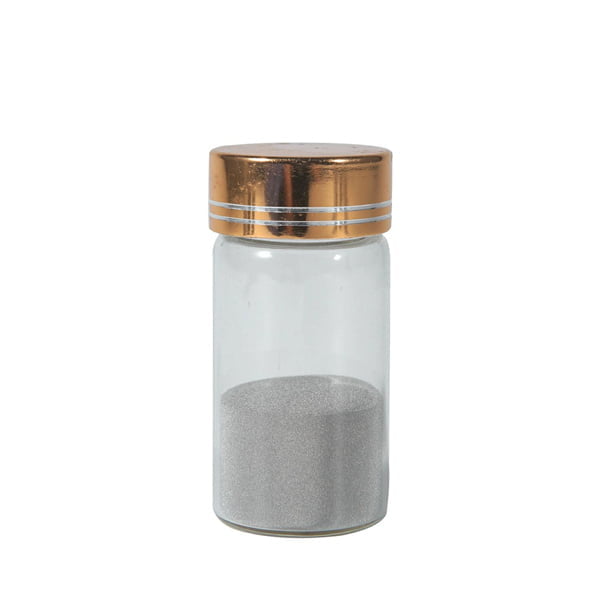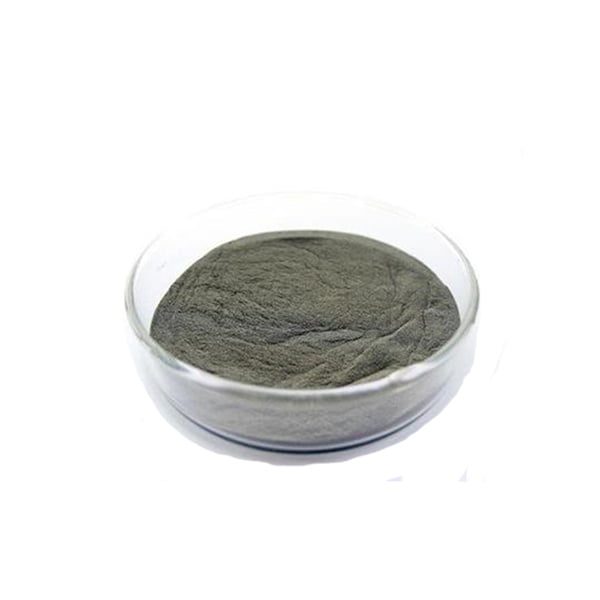Průvodce titanovými prášky
Obsah
Titanové prášky are finely divided metallic titanium particles used in various applications due to their unique properties like high strength-to-weight ratio, corrosion resistance, and biocompatibility. This guide provides a detailed overview of different types of titanium powders, their composition, properties, manufacturing methods, applications, and suppliers.
Overview of Titanium Powders
Titanium powders come in various purity levels, particle sizes, and morphologies for use in diverse applications across aerospace, automotive, chemical, medical, military, and other industries.
Key features that make titanium powders useful:
- Vysoký poměr pevnosti a hmotnosti
- Vynikající odolnost proti korozi
- Low density compared to other metallic materials
- Biokompatibilita a netoxičnost
- Schopnost odolávat extrémním teplotám
- High chemical stability across various environments
- Versatile manufacturing and processing options
With advancing technology, titanium powders with more controlled particle characteristics are being produced to meet application demands.

Typy Titanové prášky
Titanium powders can be categorized based on composition, production method, particle morphology, particle size distribution, and other parameters:
Složení titanového prášku
| Typ | Čistota | Klíčové prvky |
|---|---|---|
| Komerčně čistý titan | 99.5-99.9% Ti | Fe, C, N, O |
| Slitina Ti-6Al-4V | 90% Ti, 6% Al, 4% V | Al, V |
| Ti-3Al-2.5V alloy | 97% Ti, 3% Al, 2.5% V | Al, V |
- Commercially pure titanium has higher corrosion resistance. Titanium alloys provide increased strength.
- Other alloying elements like molybdenum, zirconium, tin, silicon, copper, and chromium can also be present depending on required properties.
Titanium Powder Production Method
| Metoda | Podrobnosti | Charakteristiky částic |
|---|---|---|
| Hydrid-dehydrid (HDH) | Ti sponge reacted with H2, then decomposed | Irregular morphology, wide size distribution |
| Rozprašování plynu | Molten Ti disintegrated by N2/Ar jets | Spherical, controlled size distribution |
| Plazmová atomizace | Higher energy than gas atomization | Spherical, fine particles |
| Indukční atomizace tavicího plynu na elektrodách (EIGA) | Combines induction skull melting with gas atomization | Spherical, controlled oxygen content |
- Gas-atomized powders have more spherical particles ideal for additive manufacturing whereas HDH powders are irregular.
- Plasma-atomized powders can produce finer particles below 15 microns.
Titanium Powder Particle Morphology
| Typ | Tvar | Textura povrchu |
|---|---|---|
| Nepravidelné | Non-spherical random shapes | Rough surfaces |
| Granulované | Rounded with visible facets | Smooth with some pits |
| Sférické | Very round overall | Very smooth |
- Particle shape influences powder flow, packing density, layer uniformity in AM processes.
- Smoother, spherical powders provide better performance in most metal AM systems.
Distribuce velikosti částic titanového prášku
Titanium powders suitable for AM processes like laser powder bed fusion (L-PBF) and directed energy deposition (DED) have particle size distributions between:
- 15-45 mikronů
- 45-150 mikronů
Finer 15-45 micron powders allow higher resolution while coarser 45-150 powders minimize entrapped gases and improve flowability.
Properties of Titanium Powders
Key properties of titanium powders are:
Table: Titanium Powder Properties
| Vlastnictví | Podrobnosti |
|---|---|
| Hustota | 4,5 g/cc |
| Bod tání | 1668°C |
| Tepelná vodivost | Low, 6.7 W/mK |
| Elektrická vodivost | Low, 0.4 MS/m |
| Chemical reactivity | Forms stable oxide layer in air |
| Mechanická síla | Vysoký poměr pevnosti a hmotnosti |
| Odolnost proti korozi | Resistant to wide variety of acids, chlorides, other chemicals |
| at elevated temperatures | |
| Biokompatibilita | Excellent, non-toxic, non-allergenic |
- The oxide layer makes titanium resistant to corrosion and provides bio-inertness.
- Titanium has the highest strength-to-weight ratio among metals after beryllium.
- Alloying improves high temperature mechanical properties significantly.
Manufacturing Methods for Titanium Powders
Commonly used techniques to produce titanium powders include:
Table: Titanium Powder Manufacturing Methods
| Metoda | Princip fungování | Charakteristiky částic |
|---|---|---|
| Hydrid-dehydrid (HDH) | Ti sponge is reacted with H<sub>2</sub> to form brittle TiH<sub>2</sub> which is crushed and decomposed to powder | Irregular shapes, wide size distribution |
| Rozprašování plynu | High velocity inert gas jets disintegrate molten titanium stream into droplets that solidify into powder | Spherical particles, controlled size distribution |
| Plazmová atomizace | Similar to gas atomization but higher energy plasma arc used | Finer spherical particles, satellite formations |
| Electrode Induction gas atomization (EIGA) | Combines induction melting in cold copper crucible with gas atomization | Finer particles, lower oxygen pickup |
Additional steps like sieving, deoxygenation or consolidation can further modify powders for specific applications.
Aplikace z Titanové prášky
Key applications taking advantage of titanium powder properties:
Table: Titanium Powder Applications
| Průmysl | aplikace | Výhody |
|---|---|---|
| Aerospace | Forging, casting engine parts; AM of airframe, turbine components | Vysoký poměr pevnosti a hmotnosti |
| Chemické | Equipment like heat exchangers, tanks, pipes | Odolnost proti korozi |
| Automobilový průmysl | Valves, connecting rods, suspensions | Lehké, odolné |
| Biomedicína | Implantáty, protézy, zařízení | biokompatibilita, osseointegrace |
| Vojenské stránky | Ballistics armor plates, vehicles | Vysoká pevnost, nízká hustota |
| Aditivní výroba | L-PBF of Ti-6Al-4V components for aerospace, automotive | Economic production of complex, lightweight parts |
- Biocompatibility allows titanium implant integration with minimal inflammatory response.
- Ability to 3D print intricate titanium components expands production flexibility.
In particular, titanium alloy Ti-6Al-4V dominates in aviation, medical implants, and metal AM applications due to its strength, workability and corrosion resistance combined with commercial availability.
Specifikace titanového prášku
Industrial titanium powders for AM and other applications need to conform to specifications for composition, particle size distribution, morphology, flow characteristics, impurity levels and other parameters.
Table: Titanium Powder Specifications
| Parametr | Typical specification | Test method |
|---|---|---|
| Velikost částic | 15-45 μm; 45-150 μm | Laser diffraction, sieve |
| Tvar částic | Aspect ratio below 3 | Mikroskopie |
| Zdánlivá hustota | Above 2.5 g/cc | Hallův průtokoměr |
| Hustota poklepání | Až 4 g/cc | ASTM B527 |
| Průtoková rychlost | 25-35 s/50g | Hallův průtokoměr |
| Obsah kyslíku | Below 0.2 wt% | Fúze inertních plynů |
| Obsah dusíku | Below 0.05 wt% | Fúze inertních plynů |
| Obsah vodíku | Below 0.0125 wt% | Fúze inertních plynů |
Meeting powder quality benchmarks ensures consistency, reliability and performance in AM production.
Suppliers of Titanium Powders
Key titanium powder manufacturers and suppliers globally include:
Table: Titanium Powder Suppliers
| Společnost | Třídy prášku | Výrobní metody |
|---|---|---|
| AP&C | Ti-6Al-4V, Ti-64 ELI, Ti Grade 2 | Plazmová atomizace |
| Technika TLS | Ti-6Al-4V, Ti Grade 2, Ti Grade 5 | Rozprašování plynu |
| Praxair (T.I.P.) | CP Ti, Ti-6Al-4V | Více |
| SLMP Mallory | CP Ti, Ti-6Al-4V | HDH, Gas atomization |
| Přísada pro tesaře | Ti-6Al-4V | Rozprašování plynu |
| Sandvik | Multiple Ti alloys | Plazmová atomizace |
| Technologie LPW | CP Ti, slitiny Ti | Plazmová atomizace |
Prices vary from $50/kg for irregular powder to over $1000/kg for highly spherical plasma atomized materials used in demanding applications like aerospace components.
Comparison of Titanium Powders
Table: Comparison of Titanium Powder Types
| Parametr | HDH powder | Rozprášený plyn | Rozprašování plazmou |
|---|---|---|---|
| Tvar částic | Nepravidelné | Zaoblené | Vysoce sférický |
| Size range (μm) | 50-250 | 15-150 | 5-45 |
| Production cost | Nízký | Mírný | Vysoký |
| Obsah kyslíku | Vyšší | Dolní | Nejnižší |
| Používá | Lisování a spékání | Metal injection molding, hot isostatic pressing | AM (DED, L-PBF) |
HDH powders are less expensive but irregular particles limit use to press and sinter technologies while plasma atomized powder, despite high cost, provides excellent flow and melting properties for demanding additive manufacturing. Gas atomized powder offers a good balance for most applications.
Výhody a omezení Titanové prášky
Table: Advantages and Limitations of Titanium Powders
| Výhody | Omezení |
|---|---|
| Vysoký poměr pevnosti a hmotnosti | Drahé ve srovnání s ocelí |
| Zachovává si vlastnosti při zvýšených teplotách | Vyžaduje zpracování v řízené atmosféře |
| Resistant to wide range of chemicals | Nízká tepelná vodivost |
| Completely recyclable | Susceptible to contamination like oxygen pick-up |
| Nemagnetické a nejiskřící | Difficult to machine in certain alloy forms |
| Readily fabricated into complex shapes | Limited supplier base especially for high grade powder |
Titanium’s merits make it suitable for specialized applications despite drawbacks like high cost and sensitivity to contamination during reuse or recycling.

Často kladené otázky
1. Why is high purity important for titanium powders meant for medical or aerospace applications?
High purity minimize adverse biological responses and ensure reliable performance under demanding service conditions over product lifetimes spanning decades. Trace elements can negatively impact mechanical properties or corrosion resistance.
2. What is the benefit of spheroidal titanium powders for AM?
Spherical powders with smooth surface texture provide excellent flowability, spreadability, packing density and layer uniformity during laser or e-beam melting processes, resulting in higher quality 3D printed components.
3. Which titanium powder production method yields finest particle sizes?
Plasma atomization of titanium can yield extremely fine particles down to 5-15 micron range owing to higher energy input, allowing very high resolution AM processing. However, productivity is lower than gas atomization.
4. Why is gas atomization the most popular titanium powder making method?
Gas atomized powders offer a good balance of particle size distribution, spherical morphology, bulk density and moderate oxygen pickup during production at reasonable cost. This allows great flexibility in meeting specifications for pressing, AM, thermal spray or other powder metallurgy technologies.
5. What is meant by ‘satellite particles’ in plasma atomized titanium powder?
Satellites refer to very fine undersized particles that adhere to the surface of coarser particles during the rapid solidification. These satellites can get entrapped in layers, negatively impacting consolidation and density.
Souhrn
With their high strength, low density, temperature resistance, corrosion performance and biocompatibility, titanium powders serve critical applications across aerospace, medical, automotive, chemical and military sectors.
Modern gas, plasma and induction melting atomization methods can produce titanium powders with tailored particle characteristics to maximize performance in powder bed AM processes as well as metal injection molding, pressing and sintering, thermal spray, and more.
Leading titanium powder producers offer various grades including commercially pure titanium along with workhorse alloys like Ti-6Al-4V meeting key benchmarks for size distribution, shape and purity.
Despite higher costs versus steel, titanium powders provide the requisite combination of mechanical and chemical properties to justify use in mission-critical rotating parts, armor protection systems, biomedical implants and 3D printed components where performance, life span and reliability are vital.
Continuing R&D focused on powder manufacturing, post-processing, alloy development and qualification aims to expand adoption across aerospace, defense, motorsports and medical sectors where titanium’s capabilities can enable next generation transportation and health technologies.
Sdílet na
MET3DP Technology Co., LTD je předním poskytovatelem řešení aditivní výroby se sídlem v Qingdao v Číně. Naše společnost se specializuje na zařízení pro 3D tisk a vysoce výkonné kovové prášky pro průmyslové aplikace.
Dotaz k získání nejlepší ceny a přizpůsobeného řešení pro vaše podnikání!
Související články

Vysoce výkonné segmenty lopatek trysek: Revoluce v účinnosti turbín díky 3D tisku z kovu
Přečtěte si více "O Met3DP
Nedávná aktualizace
Náš produkt
KONTAKTUJTE NÁS
Nějaké otázky? Pošlete nám zprávu hned teď! Po obdržení vaší zprávy obsloužíme vaši žádost s celým týmem.

Kovové prášky pro 3D tisk a aditivní výrobu
SPOLEČNOST
PRODUKT
kontaktní informace
- Město Qingdao, Shandong, Čína
- [email protected]
- [email protected]
- +86 19116340731
















